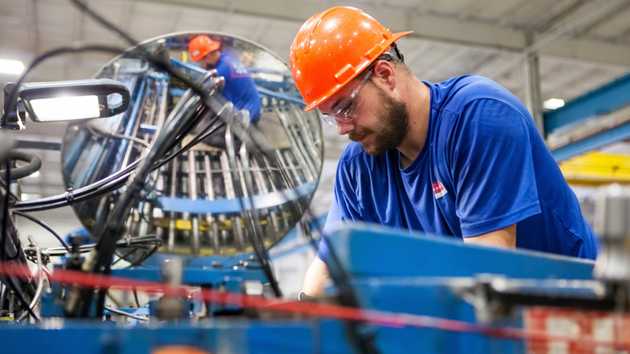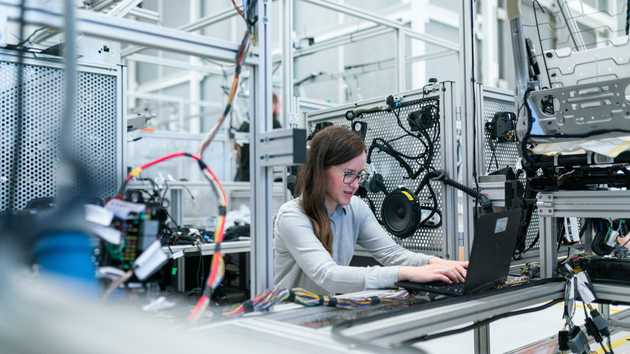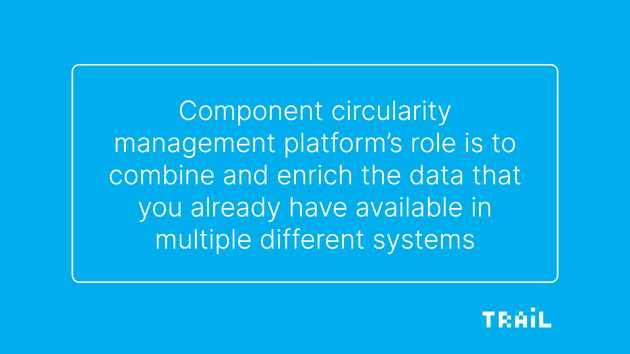Improving circular economy in all areas is a crucial step in our journey towards zero-carbon society. Pioneering companies are implementing solutions for reusing material because that is just common sense: why pay for virgin raw material when you can utilise existing material you already have?
Improving sustainability is an important factor in introducing circular thinking in your manufacturing process. However, it is not the only benefit. Component circularity will help you to create new business opportunities and streamline supply chains.
Do you want to learn more about component circularity management platform? Contact us!
Component circularity management require an efficient circularity platform and proper processes. But what are the key building blocks of component circularity management? Let’s dive into the five cornerstones that will help you to form a solid component circularity management platform for your company.
Component-level asset management ensures data reliability
Component circularity management’s goal is to maximise the number of the components’ life cycles. The longer you use the component, the less material you need to use, and the more valuable the component is to you.
Each component has a unique life cycle. They are used in different machines, reused with different intervals, maintained at different times, and dismantled eventually.
These life cycle events impact the value, condition, and estimations for the component. As a result, managing the components on a single-component level is crucial. Averages and estimations based on aggregate data alone will not give you enough data points to work on.
When building a component circularity management model, you should ensure that your platform allows to create and update at least the following data points for each component:
- Unique identifier for each component
- Manufacturing details
- Availability information
- Maintenance history and cost details
- Location information
- Condition of the component and remaining estimated lifespan
When a machine is delivered to a workshop at the end of its life, easy access to this information helps your employees to decide if the components can be reused and start their next life cycle.
Component maintenance
Maintenance and inspections are a key part of the component life cycle. Proper maintenance processes and tools that support them give the components extra lives and allow them to be returned to circulation. They are also mandatory for ensuring the component safety.
This means that your component circularity platform must come with proper tools for logging maintenance and inspection for each component. First of all, this is because the maintenance personnel need easy-to-use tools, such as a mobile app, for logging the executed maintenance.
Second, the maintenance history needs to be accessible to all relevant employees. The component maintenance history is needed to trace all past actions and analyse the impact on the component usability and value.
When designing the component maintenance section of the circularity platform, pay attention to the following details:
- Allow reporting defects and plan recurring maintenance for individual components
- Provide easy access to maintenance logs at any time to all relevant employees
- Maintenance costs should be collected per maintenance as well as the total lifetime maintenance cost of an individual component
- Employees executing maintenance should be able to log spare parts usage when maintaining components
- Easy-to-use tools, such as mobile apps for logging maintenance steps, help users to commit using the system
- Set up automated notifications of upcoming and late maintenance
Comprehensive component register for collecting the aggregate data
When you have individual component tracking with maintenance logs in place, you can collect high-quality aggregate data. Combining the single-component-level information to larger entities allow better analysis and reporting.
Aggregate data of the component should allow you to view all assets with given criteria. Efficient planning requires that you have access to, e.g., information about the component availability in different locations as well as total value of the components.
The solution for this need is an accessible asset register of all the individual components. This component register should enable you to:
- Have an overview of all of the components
- Search component data quickly
- Analyse volumes of components per location
- Prepare for upcoming component renewal needs
- Execute mass actions for the components in the system
- Export reports of the components and data points with the given criteria
Component register is the primary source for the analytics and reports you need when predicting the component usage.
Utilise existing data sources
You are probably thinking that “We have millions of components! How are we going to create a register of all of them, let alone on a single-component level?”. Most likely, you already have a lot of data sources available. You can utilise them for populating the component circularity management platform.
Component circularity management platform’s role is to combine and enrich the data that you already have available in multiple different systems.
By bringing data over APIs to the platform, you avoid the need to add data manually. It is still good to have that opportunity as well, especially when logging the maintenance tasks.
Here are a few examples of the data sources you can connect with the circularity management platform to build an efficient component circularity management model:
- Data lakes
- Manufacturing systems
- Sensors and IoT systems
- Connected machines
- Maintenance management systems
- ERP systems
Machine Learning and AI for predicting the future
Machine learning and AI are today’s buzzwords. For a good reason, though. They will provide you with an improved ability to predict the future, e.g. component availability, component expected condition, and maintenance needs.
However, machine learning and AI require tons of good quality data to work properly. You need to teach them to do what you want, and this calls for a lot of good data.
Well-designed component circularity management platform provides you with high-quality data of the components’ life cycle. When you have set up the key building blocks and collect information on a single-component level, you can utilise the data for machine learning and teaching AI to perform how you want it to.
Summary
Circular economy provides great opportunities for companies to find new business models and cut their raw material consumption. In manufacturing industry, setting up proper process for managing component circularity is a big step towards circular economy and more sustainable manufacturing.
Component circularity management cannot be built on aggregate data and averages alone. Components’ life cycles are unique and therefore component circularity management is based on managing the life cycle of components on a single-component level.
A proper component circularity management platform is needed. It is based on the following key building:
- Individual-component-level life cycle management
- Component maintenance
- Component register
- Access to data sources
- Analytics
All the requirements discussed above – individual component tracking, component register, component maintenance - can be solved with a proper asset management system. It forms a solid base for a component circularity management platform.
If you are interested in discussing component circularity management further, feel free to contact us!


